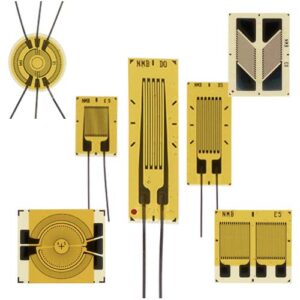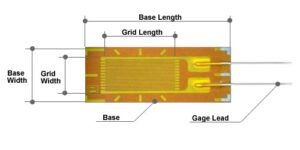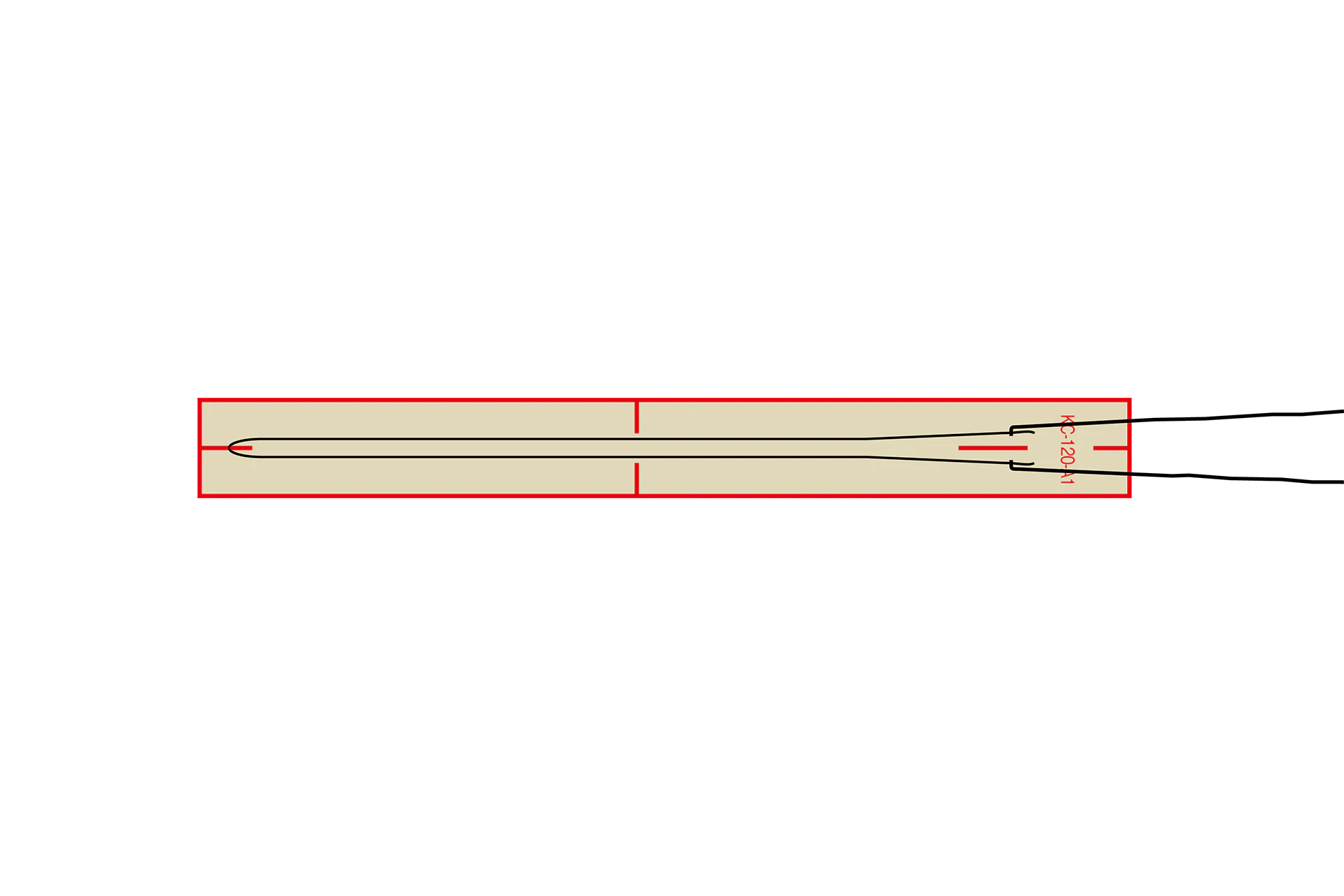Force and mechanical measuring equipment
Stress gauges detect small dimensional changes (strain) in the form of electrical signals. By measuring the strain with a gauge attached to a material or structure, the strength or safety can be known. Therefore, stress gauges are used in many different industries including machinery, automobile, electrical, civil engineering, medical and food.
Stress gauges are also used as force, pressure, acceleration, vibration, displacement and torque transducers used for a variety of purposes including measurement and production line control.
Kyowa produced the first Japan-made stress gauge in 1951, and based on the abundant experience and technology accumulated over these years, we produce a wide range of high-performance, environmentally friendly stress gauges.
Principle of stress gauge
If the external tensile or compressive force increases or decreases, the resistance will increase or decrease proportionally. Suppose the initial resistance R changes with AR due to strain &: the following equation is established.
Types of stress gauges
Stress gauges are classified into foil stress gauges, wire stress gauges and semiconductor stress gauges etc.
Structure of stress gauge
The foil stress gauge has metal foil on a thin plastic insulation layer and the test leads are attached, as shown in Figure 2 below.
The stress gauge is bonded to the measuring object using a special adhesive. The deformation occurring at the measuring location is transmitted to the stress sensing element through the adhesive and the plastic base. For accurate measurement, the stress gauge and adhesive must be compatible with the measuring material and operating conditions such as temperature, etc.
A strain gage detects a minute dimensional change (strain) as an electric signal. By measuring strain with the gage bonded to a material or structure, the strength or safety will be known. Thus, the strain gage is used in various industries including machinery, automobile, electric, civil engineering, medical, and food.
The strain gage is also adopted as a sensing element of force, pressure, acceleration, vibration, displacement, and torque transducers used for various purposes including measurement and control of production lines.

Kyowa produced the first Japanese-made strain gages in 1951, and based on the abundant experience and technology accumulated for these years, we manufacture a variety of high-performance, environmentally friendly strain gages.
Principles of Strain Gages
If external tensile force or compressive force increases or decreases, the resistance proportionally increases or decreases. Suppose that original resistance R changes by AR because of strain &: the following equation is set up.
Types of Strain Gages
Types of strain gages are classified into foil strain gages, wire strain gages, and semiconductor strain gages, etc.

Structure of a Strain Gage
The foil strain gage has metal foil on the electric insulator of the thin resin, and gage leads attached
The strain gage is bonded to the measuring object with a dedicated adhesive. Strain occurring on the measuring site is transferred to the strain sensing element via adhesive and the resin base. For accurate measurement, the strain gage and adhesive should be compatible with the measuring material and operating conditions such as temperature, etc.

KYOWA Strain gage bonding installation procedure
KYOWA KFGS General-purpose Foil Strain Gages
New strain gages with the world highest level performance.
| Materials Resistive element | CuNi alloy foil |
|---|---|
| Materials Base | Polyimide |
| Operating temperature in combination with major adhesives after curing (°C) | CC-33A: -196 to 120ºC CC-35: -10 to 120ºC CC-36: -30 to 100ºC EP-340: -55 to 150ºC PC-600: -196 to 150ºC |
| Operating temperature in combination with major leadwire cables (°C) | Polyester-coated copper wire: -196 to 150ºC Vinyl-coated flat cable (L-6, L-7): -10 to 80ºC Mid-temperature cable (L-11, L-12): -100 to 150ºC |
| Self-temperature-compensation (°C) | 10 to 100ºC |
| Applicable linear expansion coefficients (×10-6/℃) | 5, 11, 16, 23, 27 |
| Strain limits at normal temp. (approx. %) | 5.0 |
| Fatigue lives at normal temperature. (times) | 1.2×107 (±1500μm/m) |
When ordering, specify the model of the strain gage and the code of the lead-wire cable with a space in between.
Eg
KFGS-5-120-C1-11 With 2 polyester-coated copper wires 15 cm long
→KFGS-5-120-C1-11 N15C2
KFGS-5-120-C1-11 With a vinyl-coated flat 2-wire cable 5 m long
→KFGS-5-120-C1-11 L5M2R
KFGS-5-120-D17-11 With a vinyl-coated flat 3-wire cable 5 m long
→KFGS-5-120-D17-11 L5M3S
KFGS-5-120-C1-11 With a mid-temperature 3-wire cable 5 m long
→KFGS-5-120-C1-11 R5M3
KFGS-5-120-D17-11 With a mid-temperature 2-wire cable 5 m long
→KFGS-5-120-D17-11 R5M2
If no lead-wire cable code is suffixed, the gage is delivered with gage leads only.
(Silver-covered copper wires 25 mm long)

How to bond KYOWA KFRS miniature strain gages on a PCB

Featuring a longer gage length, the KC series gages are wire strain gages suitable for mean strain measurement of concrete under test. Usually, a model with the gage length over 3 times longer than the maximum diameter of the aggregate (gravel, sand, etc.) is selected for the purpose.
When ordering, suffix the lead-wire cable code to the model number with a space in between.
Eg
For the gage with a vinyl-coated flat 2-wire cable 5 m long
→ KC-120-120-A1-11 L5M2R
If no lead-wire cable code is suffixed, the gage is delivered with gage leads only.
(Silver-covered copper wires 30 mm long)
Pic.: KYOWA Strain gauges type SKS-3032 (1000ohm/ 4pcs/box) at Semiki's warehouse
Maintenance and calibration :
► We also have calibration certificate attached ( optional )
► Please re-calibrate after use for a certain period through our purchase store.

DISTRIBUTED BY:
Semiki instrumentation Co., Ltd
Email: sales@semiki.com
Office tel: +84 28 2253 3522
~DOING OUR BEST FOR YOU~